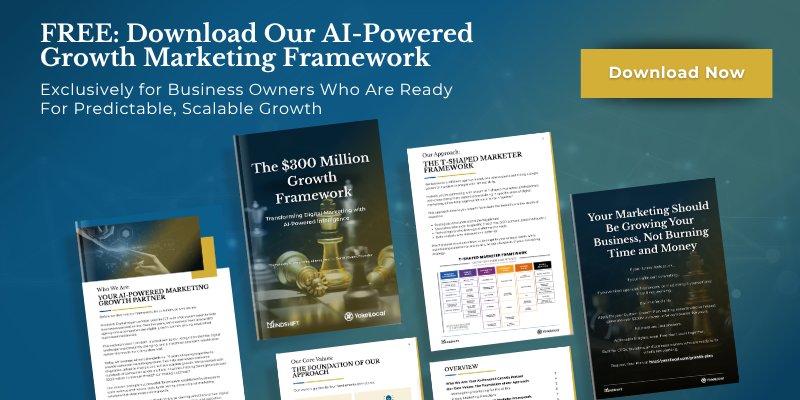Your lead generation strategy is up and running — you’ve built it but they aren’t coming. It’s a common problem, especially for folks who have implemented a rocky strategy with their lead generation tactics.
Lead generation is one of the most important strategies to create when planning your marketing. Not only is it important for you to gain prospects, but it allows you to track how people find your site, where they’re becoming leads, and maybe most importantly, where they are leaving your site and becoming a lost lead.
Here we’ll break down the problem, address why your lead generation strategy isn’t working, and offer solutions to get you on track.
A Lead Generation Strategy Means You're Not Shooting In The Dark
Lead generation, commonly known as lead gen, is the process your company undergoes to attract prospective customers or clients. Lead generation is crucial for your sales and business development. When there are no leads coming in, whether that’s through inbound or outbound strategies, your business is at risk for lost revenue.
Having no lead gen strategy can truly hurt your sales pipeline. Essentially, it means there are no new prospects finding or showing interest in your services. Similarly, if you haven’t diversified your lead strategy, your pipeline is likely vulnerable to one lead gen activity, which can also disrupt your sales pipeline.
A lead generation strategy means you’re not shooting in the dark. You’re not just throwing spaghetti on the wall to see what sticks. Having a strategy can help you forecast and plan your marketing, sales, and overall operations. This is why automating your lead gen activity can help you stay efficient and save time. Automated lead gen systems are often the most efficient way to generate new leads for your business.
8 Reasons Why Your Lead Generation Strategy Isn't Working
When you first create your marketing strategy, your lead generation is likely top of mind. After all, marketing is meant to bring in and attract new prospects. But if your lead generation isn’t working, then you’re not seeing the results you need. When lead gen falls short it can create chaos and anxiety within an organization. Avoiding all that is ideal.
So if you’re wondering why your lead generation isn’t working, here are eight likely culprits.
You don't understand your buyer persona
Understanding your ideal client or customer is so important to crafting an effective lead generation strategy. When you understand who is engaging with your services, you’re more inclined to understand how to talk to them. Instead of writing messages that are broad and seemingly appeal to everyone, knowing your buyer persona allows you to write clear and concise marketing messaging and design outreach tactics that truly reach them and persuade them to contact you or hire your firm.
So what is a buyer persona? A buyer persona is a detailed description of your ideal client, customer, or buyer. It includes demographic data like their age, gender, and income. But it also includes psychographic data like their behaviors, their purchasing decisions, and what drives them.
Crafting a buyer persona is a detailed process that will help your lead generation strategy become more effective because you’ll be able to tailor your messaging and marketing to a specific target audience.
the landing page isn't doing it's job.
So you’ve got your buyer persona but you’re still not getting the leads you’d like. One probable cause of your woes is an ineffective landing page. A landing page is a web page for a prospect to land and makes a quick decision to engage. This can look like filling out a form or downloading an eBook.
There could be a couple of reasons why your landing page isn’t converting the users on your site:
- Poor messaging that isn’t clear for the user.
- Too much content overwhelming them
- Too many links that drive the user from the page
- Slow loading time (the page should load immediately)
If this sounds accurate, try fixing the issues in order to create a landing page that converts quickly. If you’re stumped on messaging and content, consider hiring an digital marketing agency to help design a page meant to convert.
you have a weak or non-existent call-to-action
The purpose of your landing page is to generate leads to your services. When you have a weak or non-existent call-to-action on your landing page, then prospects don’t know how or why they should be giving you their information – the exchange isn’t clear.
When users are confused, they likely bounce from your page and look to your competitors, because they want their problem solved with the services you offer, but your call-to-action isn’t clear enough for them to engage.
Consider having concise bullet points on exactly what they’ll expect when they fill out the form. What they’ll gain by working with you and how the process will go — from a very high, not-overwhelming vantage point.
the content offer or incentive isn't appealing to your target audience
If you have a landing page that’s concise and a call-to-action that feels straightforward and still isn’t converting your leads, it could be due to an offer that isn’t appealing to your target audience. This ladders up to the importance of creating a buyer persona because then you’ll know the messaging and pain points that may work best for your target audience.
Filling out a form and pledging “you’ll get back to them,” may not be appealing to your audience. Try giving them something in return. Be it an eBook or a useful exercise they can practice while they wait for you to contact them.
Giving your target audience something in exchange for giving their contact information is a reciprocal exchange. Not only does it help the lead understand your services and approach, but it also builds trust with them. You said you’ll do something, and then you do it.
you aren't nurturing the leads.
OK, so maybe you ARE getting leads, but they aren’t turning into customers. It could be a nurturing vs. generating problem. Putting all your eggs in the lead generation basket and not nurturing them can impact you negatively. After all, if you aren’t turning them into deals, then your bottom line suffers.
Nurturing a lead is just as important as the initial first contact. If your business sells more complex and expensive products or services, prospects may take a long time with their purchasing decision. Nurturing a relationship with them keeps you top of mind while building trust.
Lead nurturing doesn’t have to be incessant. You can stay in contact with a lead without overbearing them with your content and sales lingo. Using a CRM to manage the relationship with your prospects is helpful in maintaining a relationship before they make a purchase.
the landing page and opt-in form aren't mobile friendly.
Mobile optimization can make or break your lead generation strategy. In 2022, mobile is set to account for 46% of traffic across the entire internet. That is a huge market share and if your landing page or opt-in form isn’t optimized or designed for mobile, then you’re missing out on a huge opportunity.
Your entire website should be mobile-friendly. When users can’t engage properly on your site on their phones, they’re likely to leave your site immediately. Fixing this issue is paramount in addressing and enhancing your lead generation strategy.
you're buying leads.
Buying any type of relationship usually doesn’t make for a lasting, trusting bond. This goes the same for buying your leads or buying a mailing list. This is your typical quality over quantity analogy. It makes much more sense to have a few quality leads than a large number of leads who don’t want to be engaged with your business or services.
Instead of buying leads, create a strategy and campaign to grow your audience. This is essentially a form of lead generation, but understanding that they likely won’t make a purchase right away. This is a form of audience nurturing - it’s building trust with thoughtful and useful content for your ideal client.
Hiring an agency to work with you on campaign creation is a great way to grow your audience organically.
you set it and left it, without carefully monitoring its progress.
Lead generation can easily be an automated process. But automation is not synonymous with setting and forgetting. Automation creates efficiencies within your pipeline, it doesn’t replace the sales cycle. It doesn’t replace the need to nurture and follow up, and it doesn’t replace the need for real humans to connect with people.
Carefully monitoring your lead generation strategy allows you to adjust as you go. You can carefully monitor and track your successes and build on them. Refining the strategy as you go and bolstering your prospect list.
Need an Inbound Lead Generation Strategy That Works?
When your inbound lead generation isn’t working, it can be a real bummer. There is so much time and effort put into the right marketing, so it’s important that the strategy behind it is effective. Fixing inefficiencies in your lead gen strategy can help you gain a better insight into your current areas of opportunity and set you apart from your competitors.
Looking to enhance your digital marketing strategy? Our Digital Growth Mastery membership will teach you how to maximize your brand's online visibility, get tons of targeted traffic, generate high-quality leads, while you grow your sales exponentially.
Contact us today to get started on designing a lead generation strategy that converts!











